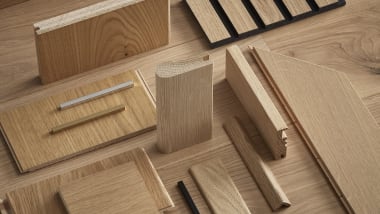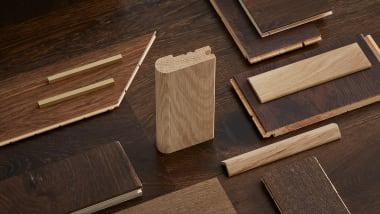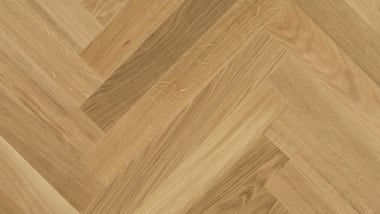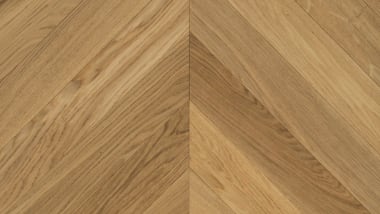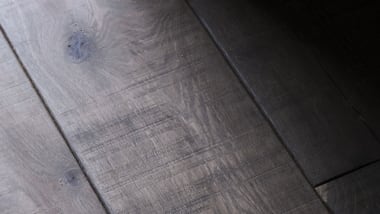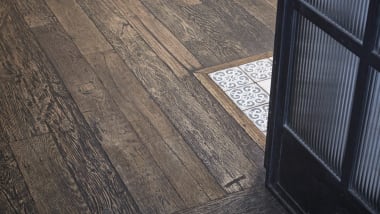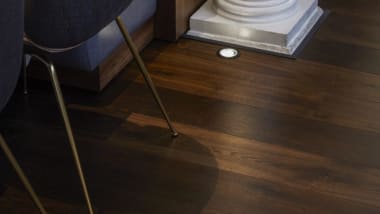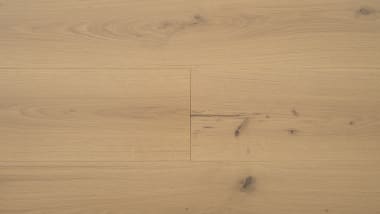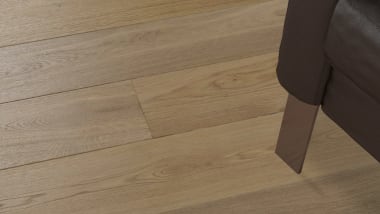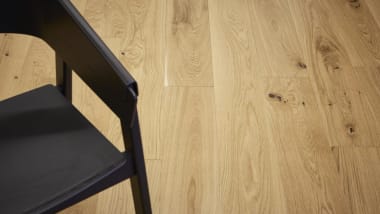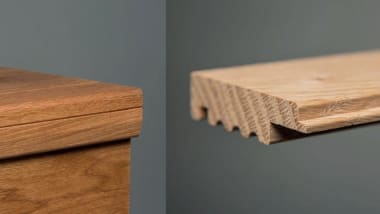Frequently Asked Questions
Choosing Wood Flooring
Floating floors with a click system joint between planks can be laid without bonding them to the sub-floor. These floors can be uplifted and re-laid several times. Nearly all Havwoods floors can be sanded and refinished to prolong their life and change their appearance, if desired, so the floor doesn’t need replacing when you want to redecorate – something which is unique to wooden floors.
This can vary depending on the specification of your product and whether the product is being used in a residential or commercial setting. Typical residential warranties are between 10 and 20 years.
An engineered board is, quite simply, a wood board which consists of more than one layer. By placing each layer so that the grain runs perpendicularly it becomes virtually impossible for the timber to swell or shrink with changes in humidity and so it dramatically increases the stability. The top layer of an engineered board (the lamella) is solid wood, usually hardwood, and may be anything from 2 to 6mm thick; obviously the thicker the surface layer the more times it can be sanded and refinished to remove the ravages of wear; the thickest wear layers are equivalent to those on solid timber boards. The lamella is securely bonded to one or two further layers – this may be a multi-layered plywood or a sandwich with either a softwood or hardwood core.
Engineered boards should not be confused with laminate or veneer. Laminate uses an image of wood on its surface whilst veneer uses only a very thin layer of wood over a core of some type of composite wood product, usually fibreboard.
Engineered wood flooring is now the most common type of wood flooring used globally and the technology has enabled the production of much wider boards as well as the application of an enormous variety of really interesting finishes.
A solid wooden floor is milled form a single piece of wood and is uniform throughout. An engineered floor has a hardwood top layer with cross-laminated layers of timber beneath to add structural stability. This reduces movement and increases stability under exposure to varying temperature and humidity in the environment.
No matter how well seasoned, oiled, waxed or lacquered it may be, wood remains hydroscopic. This means that when the humidity is high it will absorb some of that moisture, swell and rise or ‘crown’ in the middle. If that same piece of timber is placed in a dry environment – as happens when using heating or air conditioning – it will release its moisture, dry out and shrink. Lay pieces of timber side by side in a confined space and those changes in humidity, over time, may well result in them bowing, warping, cupping or gapping – gaps between the planks. This is what can happen with a solid timber floor, wall or ceiling.
Engineered boards are like solid timber planks with lots of benefits:
- They are far more stable than solid timber planks so there is far less likelihood of eventual problems and much wider boards can be produced.
- Engineered boards are usually available pre-finished which means a reduced installation time and no surprises on site.
- Unlike the vast majority of solid timber planks, engineered boards can usually be fitted over underfloor heating.
- Engineered boards make far more efficient use of slow-growing, lamella layer timbers (oak, walnut, etc).
- Engineered boards offer alternative, easier methods of installation.
Oil penetrates deep into the timber and brings out the true beauty of both the colour and grain as well as providing protection for the floor. In addition to providing a natural look, oiled floors lend themselves to being spot repaired in the event of surface damage.
Most oiled floors require an additional coat of oil or Hardwax Oil, a mixture of sunflower, soybean and thistle oil, carnauba and candelilla wax after installation. This is micro-porous, water-repellent, dirt-, wear-, and stain-resistant against wine, beer, cola, coffee, tea, fruit juices and milk; it will not crack, flake, peel or blister.
Lacquer is normally a polyurethane coating which is applied to the surface of a wooden floor by brush or roller. The polyurethane covers the pores of the wood and forms a hard, resilient coating which protects the timber from dirt and moisture ingress. A good quality lacquer will protect a timber floor for anything from 12 months to 6 years, depending upon the amount of foot traffic.
Installation
As a general rule, Havwoods do not recommend the use of solid wood over underfloor heating. The majority of engineered boards are, however, perfectly suited to use with underfloor heating; this is particularly true of those with an oak lamella and less likely to be so for ones using exotic woods. Always check with Havwoods before specifying any wood floor for use with underfloor heating.
The area(s) of installation will dictate the wastage on any installation, with small areas requiring more wastage than open spaces. For planks we typically advise on 8-12% wastage and patterned floors, such as herringbone or chevron, may need 15-20% wastage. Always consult with the installer for accurate wastage calculations.
The order quantity will be the net measure of the areas where the product is to be installed plus the wastage allowance (see above).
Wood is a natural material which passively changes its moisture content to reach equilibrium with its environment (hygroscopy). At times of the year where humidity is higher, wooden floors will take on moisture from the air and this causes some expansion. Equally, when humidity decreases, the floor will contract slightly The expansion gap allows for this expansion to occur without creating any tension in the floor from the wood pushing against walls, door frames, pipes etc.
A floating floor installation is one where the planks are attached to each other instead of to the subfloor over which it is being laid. It is a fast, relatively easy method of fixing which allows some room for movement and expansion given changes in humidity; the floor can be removed easily too, making it ideal for commercial applications where the flooring is more likely to be changed within the foreseeable future. Floating installations are usually associated with the fitting of engineered timber floors but, in fact, solid timber boards can also be laid floating over a suitable subfloor providing a damp-proof membrane is laid and Elastilon employed.
Wood is a natural material and each piece of each tree will vary in colour and grain structure. Colour variation is dictated by the age, location, exposure, soil pH and multiple other factors during the growth of the tree.
Care and Maintenance
Wooden floors contribute to a healthy living environment for all of the family, including pets. It is important to keep pet claws trimmed to reduce any abrasion that these can cause. Maintenance products can be applied to all of our floors to reduce the appearance of minor scratches over time.
The vast majority of Havwoods floors can be sanded and refinished multiple times over their lifetime. Each time a floor is sanded, the appearance can be tailored to fit the decoration scheme of the room/area where the floor is installed.
Oiled wood floors are very easy to care for. For everyday cleaning to remove dust or loose debris a broom, vacuum cleaner or dry mop is all that is required. For more thorough cleaning, damp mop using a diluted oiled wood floor cleaner. In public places where the footfall is greater, oiled wood floors may be damp mopped on a daily basis and should be treated regularly with a maintenance wax. This may be applied to the most heavily used areas or to the whole floor, spreading it with an electric, single-disc buffing machine with a beige pad. Maintenance wax need only be applied to residential flooring when the wood begins to look a little lifeless.
Day-to-day cleaning involves sweeping your floor and cleaning with a spray-mop and the correct cleaning solution for the surface finish. Periodic maintenance can be carried out on all floors through the application of a maintenance product, such as a refresher for lacquered floors or Liquid Wax Cleaner for UV oil, natural oil and hard-wax oil finishes.
A properly installed and maintained wooden floor will last for many years (and decades). Havwoods offer varying specifications of product which have different designed lifespans.
All Havwoods floors are tested for stain and spillage resistance When floors are being installed into commercial spaces or busy kitchens, it is often a good idea to apply maintenance products soon after installation to ensure that the surface finish is maintained in these more demanding areas.
Dents and scratches may occur over time these can be fixed with the application of maintenance products or easy to use repair kits.
Certification
For a full explanation of the different wood grades available, and to download our information sheets, please see our page on wood flooring grades.
Wood Grading
FSC® stands for Forestry Stewardship Council. It is an independent, non-governmental, non-profit-making organization established to promote the responsible management of the world’s forests. The FSC principles and criteria aim to ensure that forest can be managed to meet the social, economic, ecological and cultural needs of both present and future generations. Products may be from an FSC source but cannot carry the FSC label unless the chain of custody throughout is FSC approved.
The PEFC (Programme for the Endorsement of Forest Certification) is the world’s largest forest certification organization. It is international and non-governmental and tends to be the certification system of choice for small forest owners. It sets very high standards for certification including the maintenance of biodiversity, the protection of ecologically important areas, the prohibition of most hazardous chemicals and GMOs and the protection of workers’ rights and welfare.
FLEGT (Forest Law Enforcement, Governance and Trade) is Europe’s response to the problem of illegal logging, a practice which can have a lasting impact on the world’s most valuable forests. The FLEGT Action Plan provides a number of measures to exclude illegal timber from markets, as well as to improve the supply of legal timber and increase demand for responsible wood products. Foremost amongst these are Voluntary Partnership Agreements between the European Union and timber exporting countries in Africa, Asia and Central and Southern America which aim to guarantee that the timber exported to the EU is from legal sources and to help these partner countries in improving their own regulation and governance. At the centre of these VPAs is a Legality Assurance System which, whilst varying from country to country, in essence consists of the verification of forest operations and the control of its transport and processing through the different ownerships for harvesting to the point of export. From 3 March 2013 the EU Timber Regulation will prohibit the first placing of illegally produced wood products on the EU market. This means that timber imported into an EU port from a country which has a VPA will have to carry a valid FLEGT licence; from countries who do not have a VPA with the EU it will be the responsibility of the importer to ensure that their due diligence system is robust enough to prevent illegally harvested timber from entering its supply chain.
